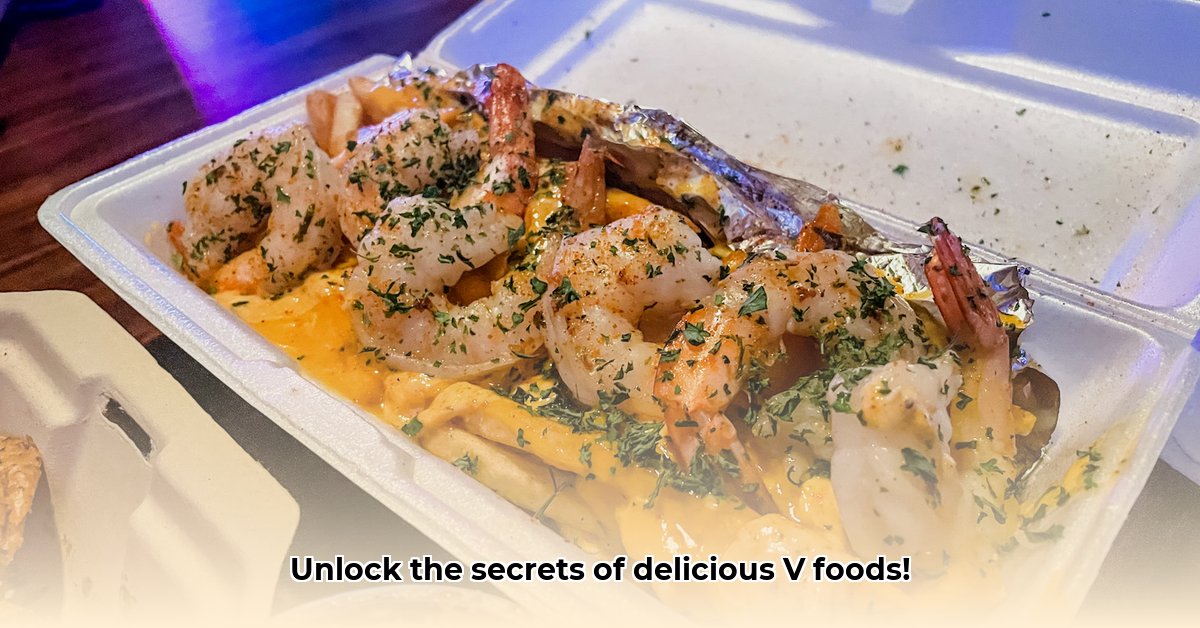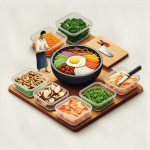Ever thought about the variety of foods starting with the letter V? From the sweet simplicity of vanilla to the hearty flavors of veal and venison, a whole world of deliciousness waits to be explored. This article guides you through these “V” foods, examining their origins, nutritional profiles, market trends, and cooking tips. Whether you’re curious about the nuances of vanilla beans, or seeking the best ways to prepare a tender veal cutlet, this is your ultimate guide. Catering to both professional chefs and home cooking enthusiasts, we dive into the world of V-inspired cuisine. For more on flavor profiles, check out this helpful guide: Flavorful Food Guide.
Food Beginning with V: A Culinary Exploration of Viands
Embark on a delicious journey through foods starting with “V,” including vibrant vegetables! From the sweet allure of vanilla to the savory depths of venison, we’ll uncover fascinating facts, explore ongoing debates, and spark your culinary curiosity. Get ready to discover some unexpected delights, including the diverse health benefits of various vegetables!
Vanilla: The King of Flavorings, Exploring Cultivation and Ethical Challenges
Vanilla conjures images of creamy ice cream, rich cakes, and decadent chocolates. It’s far more than just a flavor enhancer; it lends its warm, inviting aroma to countless dishes, from simple cookies to sophisticated pastries. However, this ingredient’s story is far from simple. Vanilla comes from the orchid, Vanilla planifolia, a climbing plant that demands precise tropical conditions to thrive. Consequently, pure vanilla extract is often expensive, and determining its authenticity can be challenging. Is it possible to ensure quality, ethical labor practices, and environmental sustainability in the face of these challenges?
A significant portion of what we perceive as “vanilla” flavor is actually artificial vanillin, a synthetic compound. While it offers a similar taste, it often lacks the complex, nuanced notes of real vanilla, which contains hundreds of flavor compounds. Experts suggest looking for labels explicitly stating “pure vanilla extract” or specifying the origin of the vanilla beans, such as “Madagascar Bourbon vanilla,” known for its high vanillin content and rich aroma. Educating your palate by sampling different vanilla extracts and vanilla-infused dishes remains paramount in differentiating between the authentic and the imitation. What actionable steps can consumers and manufacturers take to support authentic vanilla farming and combat potential fraud?
The vanilla orchid is particularly sensitive to climate change, leading to unpredictable vanilla bean production, which can potentially cause shortages and inflate prices. Plus, traditional vanilla bean farming isn’t always consistently sustainable. Some growers rely on harmful pesticides, while others engage in practices that contribute to deforestation. The solution lies in a combination of consumer demand for transparency, food company investment in innovative and sustainable farming practices, and ongoing research into improving vanilla production techniques and exploring more sustainable alternatives.
Actionable Insights for Vanilla:
- Consumers can actively demand more transparency from food manufacturers, insisting on sustainably sourced vanilla and seeking certifications like Fair Trade.
- Food companies should prioritize investment in innovative farming practices, such as agroforestry, and explore alternative vanilla sources, like lab-grown vanilla, for increased resilience and ethical production.
- Researchers are actively working on ways to improve vanilla production, developing vanilla varieties that are more resistant to disease and climate change and creating more sustainable alternatives to address growing concerns.
Veal and Venison: A Tale of Two Meats, Examining Ethical, Nutritional, and Sustainable Consumption
Moving from the sweet to the savory, let’s consider veal and venison. Veal, prized for its tender texture and subtly delicate flavor, comes from young calves, while venison, a richer, more intensely flavored meat, comes from deer. Is it possible to balance the culinary appeal of these meats with ethical and sustainable values, while also considering their nutritional benefits?
The methods used to raise calves for veal have sparked ethical concerns, with many believing specific practices are inhumane and unsustainable. Traditionally, veal calves were raised in confined spaces with restricted diets, leading to pale, tender meat. Modern veal farming practices are increasingly focused on improving animal welfare, providing calves with more space, access to pasture, and nutritious feed. Venison, known for its slightly gamey flavor, is considered a healthier alternative to beef, being lower in fat and higher in protein and iron. However, its distinctive taste presents a challenge for broader acceptance, as some consumers find it too strong. Both meats face competition from chicken and beef in restaurants and home kitchens, leading to a niche market position on menus. What role does transparency in farming practices, clear labeling, and consumer education play in enhancing consumer confidence in veal and venison?
The future of both veal and venison depends on increased transparency, sustainable production practices, and clever marketing that highlights their unique qualities and nutritional advantages. Meat producers can focus on ethical farming practices, showcasing their commitment to animal welfare and environmental responsibility through farm tours, detailed online information, and certifications. Restaurants can highlight the diverse flavor profiles and health benefits of veal and venison in their menus and cooking instructions, offering tasting notes and pairing suggestions. Consumers can actively seek out ethically sourced products and support businesses committed to responsible practices by looking for certifications like Animal Welfare Approved or Certified Humane. Ongoing research on ethical meat production, alternative feeding strategies, and creative culinary applications offers a promising path forward.
Actionable Insights for Veal and Venison:
- Meat producers should prioritize and increase transparency regarding animal welfare, traceability, and sustainable sourcing to foster consumer trust and promote ethical consumption.
- Restaurants can creatively promote ethically sourced veal and venison dishes, highlighting their unique culinary qualities, health benefits, and sustainable production methods to attract a broader audience and cater to discerning palates.
- Consumers should actively choose ethically and sustainably raised veal and venison products whenever possible, supporting responsible farming practices, animal welfare, and environmental stewardship.
This culinary journey into “V” foods reveals the inherent complexity behind our seemingly simple food choices. From the sweet simplicity of vanilla to the savory nuances of veal and venison, the stories behind these ingredients highlight the critical need for sustainable practices, ethical sourcing, and informed consumer choices. The future of food lies in our hands.
How to Source Sustainable Vanilla Beans for Food Manufacturing
Key Takeaways:
- Consumer demand is a strong catalyst, fueling the growing market for ethically and environmentally responsible vanilla.
- Significant challenges remain in scaling sustainable practices, especially concerning price fluctuations, climate change effects, and ensuring fair labor practices.
- Sustainability offers significant potential for improved farmer livelihoods, environmental protection, and enhanced product quality by improving farming practices, promoting biodiversity, and minimizing environmental impact.
- Success requires collaborative action from all stakeholders—farmers, businesses, consumers, and governments in a joint effort to promote responsible sourcing and support farmer communities.
Understanding the Sustainable Vanilla Market to Ensure Ethical Sourcing
Vanilla’s alluring flavor hides a complex reality. The majority of global vanilla production comes from Madagascar, Indonesia, and Uganda, where traditional farming practices often pose significant environmental risks and exploit vulnerable workers. How to source sustainable vanilla beans for food manufacturing is a crucial strategic imperative for ethical businesses committed to social responsibility and environmental stewardship. How can manufacturers ensure they are sourcing vanilla both ethically and sustainably, contributing to the well-being of farming communities and preserving the environment for future generations?
This holistic approach means ensuring fair wages and safe working conditions for farmers and laborers, actively preserving biodiversity, minimizing environmental impact through responsible farming practices, and promoting long-term sustainability by investing in community development and resource management. It’s about consciously looking beyond simply buying the cheapest beans and embracing a values-driven approach to sourcing.
Choosing Sustainable Suppliers to Uphold Ethical Standards
Finding reliable and transparent sustainable suppliers is absolutely key to ensuring ethical sourcing. Prioritize suppliers with credible certifications, such as Fair Trade, Rainforest Alliance, and USDA Organic. These certifications often signal a verified commitment to fair labor practices, environmental protection, and ecological stewardship. However, don’t solely rely on certifications as a guarantee; actively investigate a supplier’s specific practices and supply chain.
- Transparency is paramount: Demand detailed information about farming methods, worker treatment, environmental impact, and supply chain traceability.
- Traceability matters: Can suppliers effectively track their beans from the individual farm to the processing factory? This end-to-end traceability is vital for ensuring accountability, verifying ethical practices, and preventing fraud.
- Visit the source (if possible): Whenever logistically feasible, consider visiting the vanilla farms and processing facilities firsthand to gain deeper insight into the operation’s ethics and sustainability practices, according to industry insights.
Evaluating Sustainability Practices and Promoting Environmental Responsibility
Sustainable vanilla farming encompasses a comprehensive set of practices extending far beyond basic certifications. Diligently consider these critical factors when evaluating potential suppliers:
- Agroforestry: Does the supplier actively integrate vanilla cultivation with other plants, such as trees and diverse crops, to promote biodiversity, improve soil health, and enhance ecosystem resilience?
- Climate resilience: What specific steps are suppliers taking to proactively mitigate the adverse impacts of climate change on their vanilla farms, such as drought-resistant vanilla varieties, water conservation techniques, and crop diversification?
- Community involvement: Are local communities actively and meaningfully involved in vanilla farming and benefiting equitably from its production through fair wages, access to education and healthcare, and community development programs?
The Long Game: Investing in Sustainability and Long-Term Partnerships
Sustainability is not a short-term project, but rather a long-term commitment requiring sustained investment and dedication from all stakeholders. What strategic investments are most effective in advancing truly sustainable vanilla production and securing its future?
- Businesses: Invest significantly in research and development to support innovative sustainable farming practices, such as organic farming, integrated pest management, and climate-smart agriculture. Partner closely with farmers to improve their techniques, provide access to resources, and ensure fair trade practices throughout the supply chain. Effectively educate consumers about the tangible
- Your Perfect Bento Box Bag For Fresh And Tidy Meals - December 2, 2025
- Korean Meal Prep Made Easy For Delicious Weekday Meals - December 1, 2025
- Korean Food Meal Prep Makes Flavorful Weekday Meals Simple - November 30, 2025










